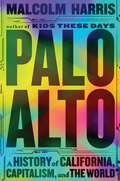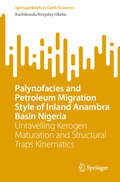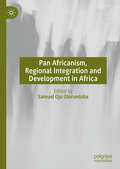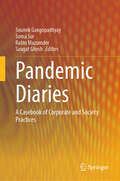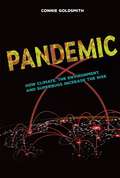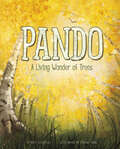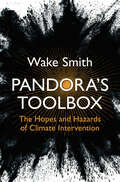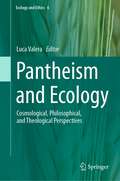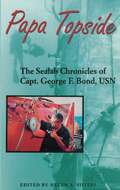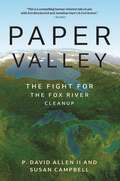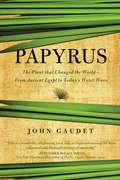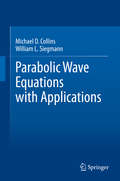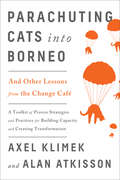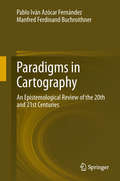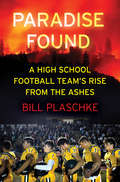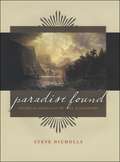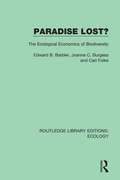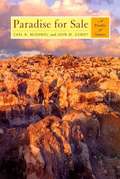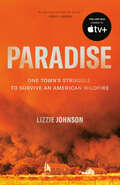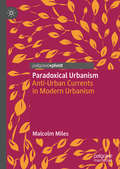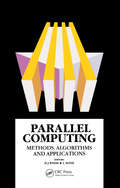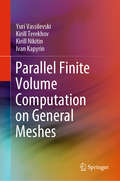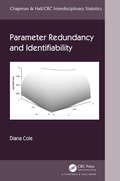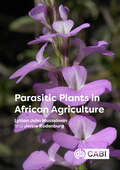- Table View
- List View
Palo Alto: A History of California, Capitalism, and the World
by Malcolm HarrisThe true, unvarnished history of the town at the heart of Silicon Valley.Palo Alto is nice. The weather is temperate, the people are educated, rich, healthy, enterprising. Remnants of a hippie counterculture have synthesized with high technology and big finance to produce the spiritually and materially ambitious heart of Silicon Valley, whose products are changing how we do everything from driving around to eating food. It is also a haunted toxic waste dump built on stolen Indian burial grounds, and an integral part of the capitalist world system. In Palo Alto, the first comprehensive, global history of Silicon Valley, Malcolm Harris examines how and why Northern California evolved in the particular, consequential way it did, tracing the ideologies, technologies, and policies that have been engineered there over the course of 150 years of Anglo settler colonialism, from IQ tests to the "tragedy of the commons," racial genetics, and "broken windows" theory. The Internet and computers, too. It's a story about how a small American suburb became a powerful engine for economic growth and war, and how it came to lead the world into a surprisingly disastrous 21st century.Palo Alto is an urgent and visionary history of the way we live now, one that ends with a clear-eyed, radical proposition for how we might begin to change course.
Palynofacies and Petroleum Migration Style of Inland Anambra Basin Nigeria: Unravelling Kerogen Maturation and Structural Traps Kinematics (SpringerBriefs in Earth Sciences)
by Kachikwulu Kingsley OkekeThis book highlights a detailed high-resolution palynofacies origin and depositional environment, source rock potential, hydrocarbon migration pathway and structural hydrocarbon entrapment mechanisms of the outcrop lithostratigraphic units of the inland Anambra basin. It broadens readers’ geoscientific conceptualization in the appraisal of the quantity and quality of outcrop scale, generated chemical macerated palynofacies elements and kerogen maturation synthesis, palynofacies hydrodynamics and sedimentary structures trapping orientation and configurations, structural mechanics and lateral facies changes. This boils down to perfect comprehension of the sedimentary, palaeontological data and natural plant evolution, growth and depositional processes in order to authenticate their origin and provenance, depositional environment and hydrocarbon production potential within the context of the basin. Presence of texturally mature coarse- to fine-grained sandstones, variable sedimentary structures, internal bed geometries and nature of bedding, age and palynofacies hydrodynamics are vital prognostic stratigraphic and paleoenvironment indices culminated in the kerogen types, organic thermal maturation, seals and reservoir rock quality along with kinematics-driven faults and joints in time and space. These geoscientific concepts were summarily authenticated in the specific objectives and chapter series of this book along with modelled prognosis for potential conventional and unconventional hydrocarbon prospects to contribute more information to oil exploration campaign in the inland basin.
Pan Africanism, Regional Integration and Development in Africa
by Samuel Ojo OloruntobaThis edited volume addresses the accomplishments, prospects and challenges of regional integration processes on the African continent. Since regional integration is a process that ebbs and flows according to a wide range of variables such as changing political and economic conditions, implications and factors derived from the vagaries of migration and climate change, it is crucial to be cognizant with how these variables impact regional integration initiatives. The contributors discuss the debates on Pan-Africanism and linking it with ongoing discourses and policies on regional integration in Africa. Other aspects of the book contain some of the most important topic issues such as migration, border management and the sustainable development goals. This content offers readers fresh and innovative perspectives on various aspects of sustainable development and regional growth in Africa.
Pandemic Diaries: A Casebook of Corporate and Society Practices
by Rabin Mazumder Soumik Gangopadhyay Soma Sur Saugat GhoshThis book provides valuable insights into the challenges faced by businesses striving for survival during the COVID-19 pandemic. It presents the grave issues encountered during the pandemic, highlighting the threats and the strategies adopted to seize opportunities in adversity. Through a case-based approach, the book explores recent trends, issues, and best practices in Corporate Governance, Corporate Social Responsibility, Information Technology, Psychological Stability, Marketing, Human Resource Management, and Sustainability. The primary objective of this book is to help readers comprehend the strategic management practices essential for business survival during times of crisis. It examines the innovative approaches and practices adopted by businesses during the pandemic and evaluates their effectiveness in ensuring sustainability. The authors analyze sustainable issues from both subjective and objective dimensions, offering a comprehensive understanding of sustainable practices in the corporate world. Each chapter of the book presents strategic applications of innovative practices and trends in various management fields. The narratives present strategic case studies in marketing management, human resource management, financial management, and supply chain management, providing valuable insights for aspiring managers, practitioners, and researchers alike.
Pandemic: How Climate, the Environment, and Superbugs Increase the Risk
by Connie GoldsmithThroughout history, several deadly pandemics brought humanity to its knees, killing millions, and recent outbreaks of Ebola and Zika took coordinated international efforts to prevent them from spreading. Learn about factors that contribute to the spread of disease by examining past pandemics and epidemics, including the Bubonic Plague, smallpox Ebola, HIV/AIDS, and Zika. Examine case studies of potential pandemic diseases, like SARS and cholera, and find out how pathogens and antibiotics work. See how human activities such as global air travel and the disruption of animal habitats contribute to the risk of a new pandemic. And discover how scientists are striving to contain and control the spread of disease, both locally and globally.
Pando: A Living Wonder of Trees
by Author Kate Allen FoxPando is an inspiring tribute to a Utah grove of quaking Aspen trees connected by their roots to form one of the world's oldest and largest living things. Author Kate Allen Fox engages readers’ senses to help convey the vastness of Pando, the challenges it faces, and how we all can be part of the solution. With lyrical poetry, Fox summarizes the science, action, and compassion needed to save this wonder of nature.
Pandora's Toolbox: The Hopes and Hazards of Climate Intervention
by Wake SmithReaching net zero emissions will not be the end of the climate struggle, but only the end of the beginning. For centuries thereafter, temperatures will remain elevated; climate damages will continue to accrue and sea levels will continue to rise. Even the urgent and utterly essential task of reaching net zero cannot be achieved rapidly by emissions reductions alone. To hasten net zero and minimize climate damages thereafter, we will also need massive carbon removal and storage. We may even need to reduce incoming solar radiation in order to lower unacceptably high temperatures. Such unproven and potentially risky climate interventions raise mind-blowing questions of governance and ethics. Pandora's Toolbox offers readers an accessible and authoritative introduction to both the hopes and hazards of some of humanity's most controversial technologies, which may nevertheless provide the key to saving our world.
Pantheism and Ecology: Cosmological, Philosophical, and Theological Perspectives (Ecology and Ethics #6)
by Luca ValeraThis book provides a comprehensive overview of the relationship between pantheism and ecology, particularly considering different cultural approaches and diverse religious, theological, and philosophical traditions. Environmental ethics arises from the dangerousness and harmfulness of human beings with respect to nonhuman species and, more generally, with respect to the environment. A common starting point for environmental ethics standpoints is that human beings are responsible for damaging nature. The famous four laws of ecology drafted by Barry Commoner precisely express this guilt on the part of human beings, who very often voluntarily violate the behavioral indications that emerge from nature itself. These aspects concern environmental ethics outlooks. Eco-theology, then, takes a further step: not only do we damage the ecosystem but also, as many authors suggest, when we humans destroy the natural world, we are wounding God. Such an idea implies a possible coincidence of God with the natural world –or the ecosystem. From this assumption, different questions may emerge: what is the kind of coincidence between God and the natural world? Are God and the ecosystem coextensive? If so, are we re-sacralizing the natural world and grounding intrinsic values in theological postulates and statements? These questions lead us to reconsider the cosmological assumptions that ground our environmental judgements, from theology to different religious traditions and cultures to philosophical worldviews. In particular, we will focus on the cosmological assumptions of pantheism (considering its differences with panentheism), discussing the symmetrical (or asymmetrical) relationships between God and the finite ways in which God manifests Godself.In this regard, the book is divided into three main parts: in the first part, the question of pantheism is approached from different traditions and with a special focus on the main thinkers in the history of thought, from Greek Stoicism to the present day. In the second part, some current ecological concerns are considered in relation to pantheistic cosmology: the authors will deepen issues from the discussion of the different “pan-conceptions” to the problem of evil, to Anthropocene. Finally, in the third part, the different chapters will focus on ethical issues in the field of the current environmental crisis with a huge connection with the pantheistic cosmologies. This book is oriented to a wide public, interested in environmental issues and looking for an approach from different cultures and traditions. Evidently, due to its “academic” nature, this book is also intended to be a great support for researchers interested in eco-theology and, more specifically, in the relationship between pantheism and ecology.It is not, in this sense, a “classic” book on environmental ethics, but a book that delves into the fundamentals of environmental philosophy, privileging the Ibero-American approach.
Papa Topside
by Helen A. SiiteriA pioneer in the field of deep-sea diving, George F. Bond helped develop the theory of saturation diving and the techniques and dive tables used by divers around the world. In this edited journal-made public for the first time-Bond offers a lively account of his work with the U.S. Navy's first manned undersea habitats, the Sealab experiments of the 1960s. Dubbed "Papa Topside" by the media who followed his work with Navy aquanauts, Bond gives a colorful eyewitness account of what today are considered benchmarks in the history of diving.This is a candid, personal record of Sealabs I, II, and III, and the FISSH experiment, the finale of Bond's career. The picture that emerges is one of a brilliant, larger-than-life figure who, though often difficult to get along with, earned the respect and affection of his peers.The book draws on the editor's interviews with Bond's fellow researchers and divers as well as Bond's daily logs and correspondence. Always frank and to the point, he describes his frustrations with the Navy brass, his friendly competition with Jacques Cousteau, and his spirited relationship with aquanaut/astronaut Scott Carpenter. As the only full-length book written about U.S. aquanauts and their undersea exploits, it is an important historical document. It is also an entertaining read.
Paper Valley: The Fight for the Fox River Cleanup (Great Lakes Books Series)
by David Allen Susan CampbellBooklist raves, Paper Valley "is a compelling human-interest tale on par with Erin Brockovich and Jonathan Harr's A Civil Action." When government scientist David Allen arrived at his new jobsite in the 1990s, the Fox River near Wisconsin's Green Bay was dominated by hulking paper mills, noxious industrial odors, and widespread ecological damage. Confronted by his lack of resources to force the politically powerful "Paper Valley" polluters to fix their mess, Allen proceeds against all bureaucratic odds in building a $1 billion case against the paper company bosses. Two small but vital players, Allen along with journalist Susan Campbell were relentless in bringing the case to the public at the time. They do so again in this book: an act of radical transparency to uncover the intrigue that nearly blocked the cleanup behind the scenes at US Fish and Wildlife, Wisconsin’s Department of Natural Resources, and the US Environmental Protection Agency. In a rare and major environmental win, the Fox River became the site of the largest polychlorinated biphenyls cleanup in history, paid for by the paper companies rather than taxpayers, to the tune of $1.3 billion, and completed in 2020. This true story of struggle, perseverance, and success inspires hope for environmentalists who strive to restore natural landscapes. The detailed account given in this book is meant to inspire and offer practical knowledge and solutions for those fighting similar opponents of environmental cleanup and restoration. Allen and Campbell eloquently outline the problematic bureaucracy involved in environmental cleanup efforts and reveal tactics to compel corporate entities who would dodge accountability for decades worth of contamination. Paper Valley is printed on recycled paper.
Papyrus: From Ancient Egypt to Today's Water Wars
by John GaudetAt the center of the most vital human-plant relationship in history, Papyrus evokes the mysteries of the ancient world while holding the key to the world's wetlands and atmospheric stability. From ancient Pharaohs to 21st Century water wars, papyrus is a unique plant that is still one of the fastest growing plant species on earth. It produces its own "soil"--a peaty, matrix that floats on water--and its stems inspired the fluted columns of the ancient Greeks. In ancient Egypt, the papyrus bounty from the Nile delta provided not just paper for record keeping--instrumental to the development of civilization--but food, fuel and boats. Disastrous weather in the 6th Century caused famines and plagues that almost wiped out civilization in the west, but it was papyrus paper in scrolls and codices that kept the record of our early days and allowed the thread of history to remain unbroken. The sworn enemy of oblivion and the guardian of our immortality it came to our rescue then and will again. Today, it is not just a curious relic of our ancient past, but a rescuing force for modern ecological and societal blight. In an ironic twist, Egypt is faced with enormous pollution loads that forces them to import food supplies, and yet papyrus is one of the most effective and efficient natural pollution filters known to man. Papyrus was the key in stemming the devastation to the Sea of Galilee and Jordan River from raging peat fires (that last for years), heavy metal pollution in the Zambezi River Copperbelt and the papyrus laden shores of Lake Victoria--which provides water to more than 30 million people--will be crucial as the global drying of the climate continues. 8 page insert, illustrations throughout.
Parabolic Wave Equations with Applications
by Michael D. Collins William L. SiegmannThis book introduces parabolic wave equations, their key methods of numerical solution, and applications in seismology and ocean acoustics. The parabolic equation method provides an appealing combination of accuracy and efficiency for many nonseparable wave propagation problems in geophysics. While the parabolic equation method was pioneered in the 1940s by Leontovich and Fock who applied it to radio wave propagation in the atmosphere, it thrived in the 1970s due to its usefulness in seismology and ocean acoustics. The book covers progress made following the parabolic equation’s ascendancy in geophysics. It begins with the necessary preliminaries on the elliptic wave equation and its analysis from which the parabolic wave equation is derived and introduced. Subsequently, the authors demonstrate the use of rational approximation techniques, the Padé solution in particular, to find numerical solutions to the energy-conserving parabolic equation, three-dimensional parabolic equations, and horizontal wave equations. The rest of the book demonstrates applications to seismology, ocean acoustics, and beyond, with coverage of elastic waves, sloping interfaces and boundaries, acousto-gravity waves, and waves in poro-elastic media. Overall, it will be of use to students and researchers in wave propagation, ocean acoustics, geophysical sciences and more.
Parachuting Cats into Borneo: And Other Lessons from the Change Café
by Alan Atkisson Axel KlimekA toolkit of proven strategies and practices for building capacity and creating transformation Recent years have seen a proliferation of information on how to make change--in business, in social and environmental movements, and on a more personal scale. But, even with all this attention, two out of three change efforts fail to achieve their desired result. How can you make your own effort buck this trend? In Parachuting Cats into Borneo, change-management experts Axel Klimek and Alan AtKisson offer crisp, concise, and targeted advice for success. They expose the most significant impediments--helping readers recognize their habitual patterns of thinking and perceiving a situation, critique their own beliefs regarding change, and then move beyond these unhelpful patterns using improved systems thinking. Named after a classic tale of unintended consequences, Parachuting Cats into Borneo delivers tools that help leaders and others keep their change initiatives on track. The advice imparted will help you move away from agonizing over immediate problems toward stoking action, identifying collaborators, focusing at the right level for your cause, and aiding others in pursuing their change. Klimek and AtKisson draw from their decades of helping corporations, networks, governments, and NGOs reach their change goals to demonstrate how to use system-based change tools to their maximum advantage. A closing section is devoted to change making in the realm of sustainability, where complexity abounds but the right tools, used well, can help us tackle some of the most significant challenges of our time.
Paradigms in Cartography
by Pablo Iván Azócar Fernández Manfred Ferdinand BuchroithnerIn this book the main trends, concepts and directions in cartography and mapping in modernism and post-modernism are reviewed. Philosophical and epistemological issues are analysed in cartography from positivist-empiricist, neo-positivist and post-structuralist stances. In general, in cartography technological aspects have been considered as well as theoretical issues. The aim is to highlight the epistemological and philosophical viewpoint during the development of the discipline. Some main philosophers who have been influential for contemporary thinking such as Immanuel Kant, Ludwig Wittgenstein, Karl Popper and Bertrand Russell, are considered. None of these philosophers wrote about cartography directly (excepting Kant), but their philosophies are related to cartography and mapping issues. The book also analyses the concept of paradigm or paradigm shift coined by Thomas Kuhn, who applied it to the history of science. Different cartographic trends that have arisen since the second half of the twentieth century are analysed according to this important concept which is implicit inside the scientific or disciplinary communities. Further, the authors analyse the position of cartography in the context of the sciences and other disciplines, adopting a positivistic point of view. Additionally, they review current trends in cartography and mapping in the context of information and communication technologies in a post-modernistic or post-structuralistic framework. Thus, since the 1980s and 1990s, new mapping concepts have arisen which challenge the discipline's traditional map conceptions.
Paradise Found: A High School Football Team's Rise from the Ashes
by Bill Plaschke"Friday Night Lights meets Unbroken." —Tony Reali | "One of the most profound stories you will ever read." —Ian O'Connor | "Plaschke delivers a masterpiece." —Jeff PearlmanFrom L.A. Times columnist and ESPN Around the Horn panelist Bill Plaschke, a story of tragedy, triumph, and the remarkable power of high school football in one small California townOn November 8, 2018, the Camp Fire ravaged the town of Paradise, California. The fire, which burned up to 80 acres per minute, killed 86 people, and nearly every building and home in the town was reduced to ashes. In a single day, Paradise, a proud working-class town in the foothills of the Sierra Nevadas, saw its population fall from 25,000 to 2,000.The Paradise High football team had long been the town’s source of joy and inspiration. But in the wake of the fire, their season was abruptly cancelled on the eve of the playoffs. Their championship hopes were gone. Their program’s survival seemed doubtful—it wasn’t even clear whether Paradise High would continue to exist.Coach Rick Prinz had planned to retire that year after guiding the Paradise High Bobcats for two decades. But after the fire forever altered his beloved town, he realized he couldn’t walk away. What ensued was the challenge of a lifetime. Of the 104 football players at Paradise, 95 had lost their homes. His varsity squad, which had stood 76 strong the previous season, was down to 22. Most of those who remained were homeless, sleep-deprived, lost. On the first day of spring practice, on a debris-ridden patch of grass at nearby Chico Airport, Prinz’s team didn’t even have a football. It was the humble beginning to a memorable journey.Bill Plaschke, longtime columnist for the Los Angeles Times, followed the Paradise Bobcats throughout a most remarkable season. In this gripping, deeply-reported story of tragedy and resilience, Plaschke reveals the unique power of sports to unite, to inspire, and to heal. As the Paradise players fought to rebuild their broken lives, they found strength in the support of their teammates—and as football returned to Paradise, so, too, did the spirit of the town itself.
Paradise Found: Nature in America at the Time of Discovery
by Steve NichollsSeamlessly blending firsthand accounts from centuries past with the findings of scientists today, Nicholls brings North America's spectacular environment back to vivid life, and illustrates how the landscape looked when early explorers first found it.
Paradise Lost?: The Ecological Economics of Biodiversity (Routledge Library Editions: Ecology #2)
by Edward B. Barbier Carl Folke Joanne C. BurgessOriginally published in 1994, Paradise Lost? is the outcome of a unique collaboration between economists and ecologists initiated by the Beijer Institute of the Royal Swedish Academy of Sciences. The book examines how the loss of biodiversity is one of the most serious problems the world faces, and suggests that new, interdisciplinary thinking is required to safeguard both us and the biosphere from the effects of species extinction. The book examines how an integrated, interdisciplinary approach to the conservation of biodiversity can understand and tackle the issue. It provides an overview of the causes of the problem, and examines previous approaches to dealing with it. The book also addresses how the loss of biodiversity affects natural systems and provides an examination of environmental policy, while discussing how this has been affected by the ecological limits to economic activity. This book will be of interest to both academics and students of environmental sciences, economics and politics.
Paradise for Sale: A Parable of Nature
by Carl N. Mcdaniel John M. GowdyThe grim history of Nauru Island, a small speck in the Pacific Ocean halfway between Hawaii and Australia, represents a larger story of environmental degradation and economic dysfunction. For more than 2,000 years traditional Nauruans, isolated from the rest of the world, lived in social and ecological stability.
Paradise: One Town's Struggle to Survive an American Wildfire
by Lizzie JohnsonThe definitive firsthand account of California&’s Camp Fire, the nation&’s deadliest wildfire in a century, Paradise is a riveting examination of what went wrong and how to avert future tragedies as the climate crisis unfolds&“A reportorial tour de force.&”—Erik Larson, author of The Splendid and the Vile On November 8, 2018, the people of Paradise, California, awoke to a mottled gray sky and gusty winds. Soon the Camp Fire was upon them, gobbling an acre a second. Less than two hours after the fire ignited, the town was engulfed in flames, the residents trapped in their homes and cars. By the next morning, eighty-five people were dead.As a reporter for the San Francisco Chronicle, Lizzie Johnson was there as the town of Paradise burned. She saw the smoldering rubble of a historic covered bridge and the beloved Black Bear Diner and she stayed long afterward, visiting shelters, hotels, and makeshift camps. Drawing on years of on-the-ground reporting and reams of public records, including 911 calls and testimony from a grand jury investigation, Johnson provides a minute-by-minute account of the Camp Fire, following residents and first responders as they fight to save themselves and their town. We see a young mother fleeing with her newborn; a school bus full of children in search of an escape route; and a group of paramedics, patients, and nurses trapped in a cul-de-sac, fending off the fire with rakes and hoses.In Paradise, Johnson documents the unfolding tragedy with empathy and nuance. But she also investigates the root causes, from runaway climate change to a deeply flawed alert system to Pacific Gas and Electric&’s decades-long neglect of critical infrastructure. A cautionary tale for a new era of megafires, Paradise is the gripping story of a town wiped off the map and the determination of its people to rise again.
Paradoxical Urbanism: Anti-Urban Currents in Modern Urbanism
by Malcolm MilesModernist urbanism seems progressive, even Utopian: design for a better world through a democratic and humane built environment. But two currents undermine this vision from within: an Arcadianism which turns to a rural idyll as retreat from change and the effects of industrialization; and an instrumentalism by which the humane vision becomes prescriptive and anti-democratic. Malcolm Miles argues that these two currents undermine modernism’s progressive vision. This book examines the roots of modernist urbanism in the seamless, self-contained systems of Cartesian space; and identifies contradictions within modernist urbanism in its instrumentalism and reliance on de-politicised professional expertise. Miles adroitly reviews the postmodern culture of industrial ruinscapes; and posits that if cities are to be places of proximity, diversity, mobility and agency, this will require a move from modernist instrumentalism to a creative and radically democratic co-production of the built environment.
Parallel Computing: Methods, Algorithms and Applications
by David J Evans; C SuttiParallel Computing: Methods, Algorithms and Applications presents a collection of original papers presented at the international meeting on parallel processing, methods, algorithms, and applications at Verona, Italy in September 1989.
Parallel Finite Volume Computation on General Meshes
by Yuri Vassilevski Kirill Terekhov Kirill Nikitin Ivan KapyrinThis book presents a systematic methodology for the development of parallel multi-physics models and its implementation in geophysical and biomedical applications. The methodology includes conservative discretization methods for partial differential equations on general meshes, as well as data structures and algorithms for organizing parallel simulations on general meshes. The structures and algorithms form the core of the INMOST (Integrated Numerical Modelling Object-oriented Supercomputing Technologies) platform for the development of parallel models on general meshes. The authors consider applications for addressing specific geophysical and biomedical challenges, including radioactive contaminant propagation with subsurface waters, reservoir simulation, and clot formation in blood flows. The book gathers all the components of this methodology, from algorithms and numerical methods to the open-source software, as well as examples of practical applications, in a single source, making it a valuable asset for applied mathematicians, computer scientists, and engineers alike.
Parameter Redundancy and Identifiability (Chapman & Hall/CRC Interdisciplinary Statistics)
by Diana ColeStatistical and mathematical models are defined by parameters that describe different characteristics of those models. Ideally it would be possible to find parameter estimates for every parameter in that model, but, in some cases, this is not possible. For example, two parameters that only ever appear in the model as a product could not be estimated individually; only the product can be estimated. Such a model is said to be parameter redundant, or the parameters are described as non-identifiable. This book explains why parameter redundancy and non-identifiability is a problem and the different methods that can be used for detection, including in a Bayesian context. Key features of this book: Detailed discussion of the problems caused by parameter redundancy and non-identifiability Explanation of the different general methods for detecting parameter redundancy and non-identifiability, including symbolic algebra and numerical methods Chapter on Bayesian identifiability Throughout illustrative examples are used to clearly demonstrate each problem and method. Maple and R code are available for these examples More in-depth focus on the areas of discrete and continuous state-space models and ecological statistics, including methods that have been specifically developed for each of these areas This book is designed to make parameter redundancy and non-identifiability accessible and understandable to a wide audience from masters and PhD students to researchers, from mathematicians and statisticians to practitioners using mathematical or statistical models.
Parameterization Schemes
by David J. StensrudNumerical weather prediction models play an increasingly important role in meteorology, both in short- and medium-range forecasting and global climate change studies. The most important components of any numerical weather prediction model are the subgrid-scale parameterization schemes, and the analysis and understanding of these schemes is a key aspect of numerical weather prediction. This book provides in-depth explorations of the most commonly used types of parameterization schemes that influence both short-range weather forecasts and global climate models. Several parameterizations are summarised and compared, followed by a discussion of their limitations. Review questions at the end of each chapter enable readers to monitor their understanding of the topics covered, and solutions are available to instructors at www. cambridge. org/9780521865401. This will be an essential reference for academic researchers, meteorologists, weather forecasters, and graduate students interested in numerical weather prediction and its use in weather forecasting.
Parasitic Plants in African Agriculture
by Professor Lytton John Musselman Dr Jonne RodenburgParasitic Plants in African Agriculture brings together for the first time in a single volume, the ecology, biology, damage, and control of all groups of African parasitic plants including both the relatively few parasites introduced to the continent as well as those native parasites that have spread from within Africa. The book covers the well-known witchweeds and broomrapes but also groups and species that have received less attention including mistletoes, dodders, rice vampire weed, and other species posing threats. The book distinguishes between stem and root parasitic weeds and between holoparasites and (facultative or obligate) hemiparasites. Based on their research and experience collectively spanning six decades, the authors provide an authoritative and state-of-the-art overview of the distribution, biology and impact of these highly specialized weeds and include recommendations for their management. Since parasitic plants in African agriculture primarily affect smallholder farmers, these weeds are explicitly discussed within a context of resource limitations and global changes. Readers are informed on all parasitic plant species relevant to African agriculture and the impact these plants have on crop production and livelihoods of smallholders in a changing world. Current and future management strategies are outlined in terms of their principles and effectiveness as well as their feasibility and affordability for farmers, all of which determine farmer adoption. The final chapter synthesises some of the relevant findings and statistics regarding parasitic weed distribution and their host crops and discusses implications in terms of future crop protection concerns in African agricultural systems. Key features: · Authoritative text based on extensive field and laboratory work. · First comprehensive state-of-the-art overview of parasitic plants and their management in Africa. · Highly illustrated with photos, graphs and species distribution maps. · Reviews previous basic and applied work, with relevance to smallholder farming systems. This book will be a valuable reference for students, researchers, extension workers, development officers, national agriculture researchers, plant pathologists, food security specialists, weed scientists, agronomists and botanists.
